Marche region census section classification in socio-economic typologies
Journal title RIVISTA DI ECONOMIA E STATISTICA DEL TERRITORIO
Author/s Adriana Conti Puorger, Pierpaolo Napolitano
Publishing Year 2011 Issue 2011/2
Language Italian Pages 30 P. 30-59 File size 782 KB
DOI 10.3280/REST2011-002002
DOI is like a bar code for intellectual property: to have more infomation
click here
Below, you can see the article first page
If you want to buy this article in PDF format, you can do it, following the instructions to buy download credits

FrancoAngeli is member of Publishers International Linking Association, Inc (PILA), a not-for-profit association which run the CrossRef service enabling links to and from online scholarly content.
Objectives The territorial partition carried out by ISTAT regarding the general population and housing censuses has been used initially for purposes of management of census operation. Subsequently, since 1981 it has assumed also an information value for a detailed analysis of the territory. The availability of such an information enables the territorial analysis beyond the boundary of administrative districts enlightening the details of the settlement and residential structure. Methods and Results The increased processing power and storage of data by means of HW and SW makes possible the application of advanced statistical methods to data sets even higher than those considered here. The k-means classification method has been applied to the Census section data. The choice has been addressed on the aggregate data published by ISTAT, considering that they could provide a meaningful reading of the territory. We present here new results of a research concerning the Marche region performed by a working group of statisticians and geographers whose aim was to identify socio-economic typologies in a region that shows great variety in its landscape. The broad size of socio-economic and demographic available data has been transformed into a synthesis of usable information. Adopting appropriate statistics methodologies and relying on the power of the currently available processors, we obtained a classification of census sections into socio-economic typologies for a new approach of interpretation of the Marche territory. Conclusions The superimposition of the results obtained by the statistical application with the principal territorial partitions (like administrative districts or Local Labour Market Areas) lead to a multi-scale analysis. Such multi-scale analysis is usable both for a deeper knowledge of the landscape and, in an operative way, for the territorial planning oriented to sustainability, policentric, choesion and competitive approaches.
Keywords: Cluster analysis, census sections, spatial models, multi-scale analysis, policentrism
Jel codes: C38, P25, R12, R14
Adriana Conti Puorger, Pierpaolo Napolitano, Caratterizzazione socio-economica della regione Marche per sezioni di censimento in "RIVISTA DI ECONOMIA E STATISTICA DEL TERRITORIO" 2/2011, pp 30-59, DOI: 10.3280/REST2011-002002